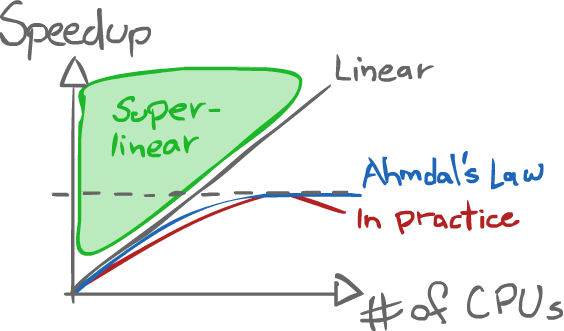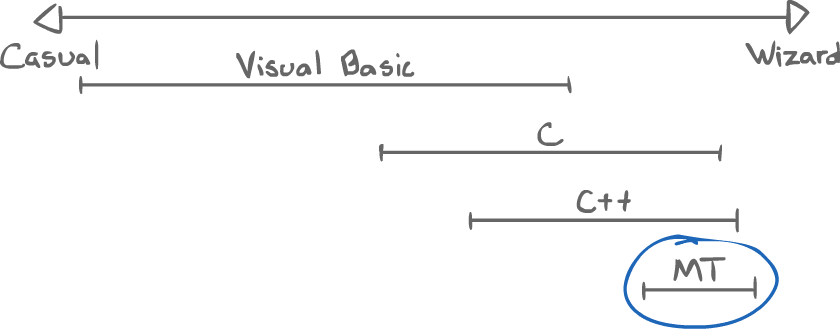1What is concurrency?¶
1.1Parallelism¶
Things happen at the same time
- Multiple processes
- User-controlled, directed
- Interaction is fully determined
1.1.1Metaphor of a Sports team¶
- The user is the coach
- The team's players are the processes
- The coach gives a precise plan for the players to follow
- Cooperative
1.2Concurrent Programming¶
Things might happen at the same time
- User initiates processes but has no precise control
- Barriers and constraints are added to achieve indirect control
1.2.1Sports team metaphor¶
- The programmer is the referee
- The referee simply says the rules of the game
- Competitive
2Multithreading vs multiprocessing¶
2.1Processes¶
A process is large and heavyweight, a major task.
It has:
- its own address space
- its own I/O
- ...
Context switching is pretty slow, because of all the exclusivity.
Inter-process communication is possible thanks to:
- Pipes
- File System
- Shared memory
- etc.
2.2Threads¶
A thread is lightweight.
- Shared address space
- Shared file handles
As such, context switching is fast.
Communication amongst threads is easy and fast.
2.2.1Issues¶
- Asynchronous: no direct control on the speed
- Synchronization: the way to set up rules/barriers is not always obvious
- Resource-consistency
- Fairness
3What is a thread?¶
3.1Lightweight processes (~ LWP)¶
"An independent flow of control within a process composed of a context (including registers and program counter) and a sequence of instructions to execute."
3.2Role of the OS¶
- Maintain thread structure
- Give threads IDs
- Apply a scheduling policy (which may be unique to threads)
- Apply priorities to threads
- Honor signal masks (thus allowing certain signals to be ignored)
3.3Thread context¶
3.3.1Things they own¶
- Registers
- Program counter
- Stack pointer (each thread has its own stack)
3.3.2Things they share¶
- Code space (they come from the same program)
- Global/static data
- Heap, dynamic data (allocated memory)
- File handles
3.4Scheduling issues¶
The OS may or may not schedule threads at the same time or concurrently.
It is our role to make programs correct, no matter how the OS handles threads.
3.5Thread mappings¶
- 1-to-1
- Create a thread; create a process
- "True concurrency" can be achieved this way
- n-to-1
- All threads are in one process
- Threads are time-sliced (mini scheduling)
- n-to-n
- The OS decides
- Some threads are mapped to some processes
3.6What are threads good for?¶
3.6.1Speedup: Amdahl's Law¶
$$t = s + \frac{p}{n}$$
Where:
- $t$: Total time
- $s$: Time of the sequential part
- $p$: Time of the parallel part
- $n$: Number of processors
The measure of speedup is calculated as the following ratio:
$$\text{Speedup} = \frac{\text{old time}}{\text{new time}}$$
Amdahl's Law can also be normalized:
$$
\begin{equation}
\begin{split}
\text{Let } t &= 1 \\
\text{ie } s+p &= 1 \\
s &= 1-p \\
p &= 1-s \\
\text{Speedup} &= \frac{1}{(1-p) + \frac{p}{n}}
\end{split}
\end{equation}
$$
3.6.1.1Example¶
Say $75\%$ of a program is parallelizable.
$$ \text{Speedup} = \frac{1}{0.25 + \frac{0.75}{n}} $$
$$ \begin{equation} \begin{split} \text{Let } n = 1 &\Rightarrow \text{Speedup } = 1 \\ n = 3 &\Rightarrow \text{Speedup } = 2 \\ n = 75 &\Rightarrow \text{Speedup } = \frac{1}{0.26} \\ n \rightarrow \infty &\Rightarrow \text{Speedup } = \frac{1}{0.25 + 0_+} < 4 \end{split} \end{equation} $$

Note: The practical line being lower than the Ahmdal's Law line, and then decreasing is due to overhead adding up.
3.6.2Hiding Latency¶
Programs have "pauses".
- I/O
- Cache misses
- Pipeline stalls
- etc.
To avoid such blocking, another thread can keep the CPU active and/or the interface responsive.
3.6.3Appropriate paradigm¶
Some problems are better solved as a multithreaded program. Using threads thus becomes the best way to write the program.
3.7Difficulties¶
- There is overhead.
- It takes more programming effort
3.7.1Programming spectrum¶


